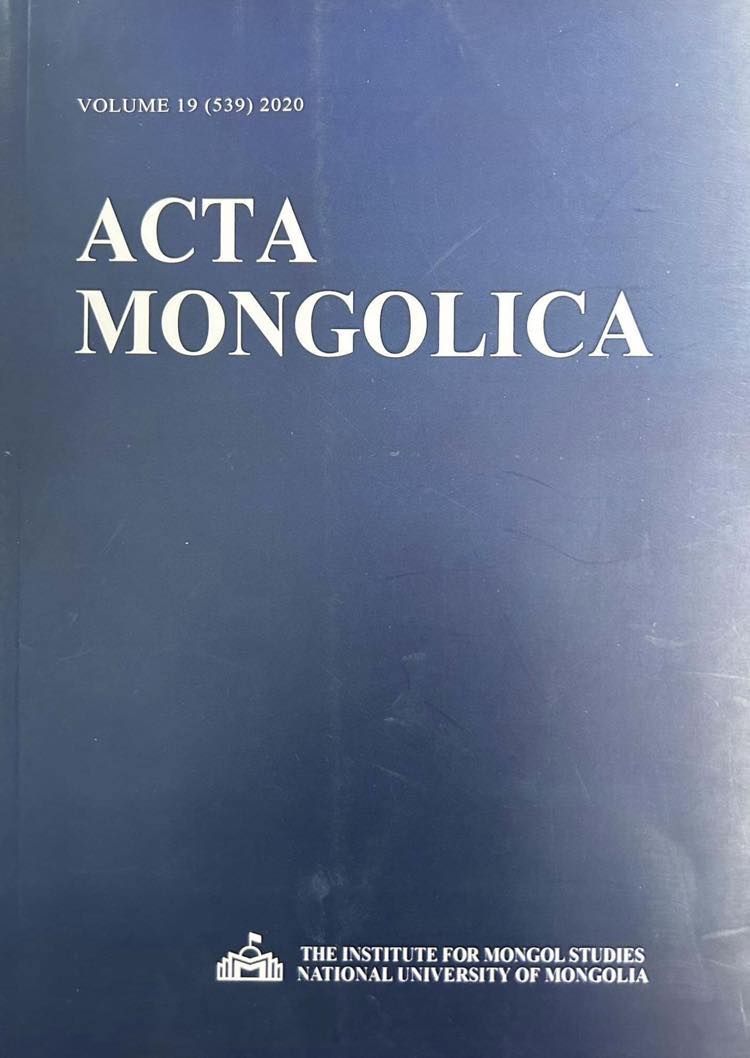Mobilities and Immobilities in Mongolia A Short Essay on Potentials and Dilemmas
Main Article Content
Abstract
After summarizing the activities of our research cluster with references to its joint theoretical background, this short essay provides comparative perspectives on potentials and dilemmas of im/mobilities in Mongolia using some examples from my research topics with a focus on modernity and mobilization.
Article Details

This work is licensed under a Creative Commons Attribution-ShareAlike 4.0 International License.
References
Abu-Lughod, Janet L. Before European Hegemony: The World System A.D. 1250–1350. Oxford University Press, 1989.
Bachmann-Medick, Doris. “From Hybridity to Translation. Reflections on Travelling Concepts.” In The Trans/National Study of Culture: A Translational Perspective, edited by Doris Bachmann-Medick, 119–136. Berlin/Boston: De Gruyter, 2014.
Chakrabarty, Dipesh. “Place and Displaced Categories, or How We Translate Ourselves into Global Histories of the Modern.” In The Trans/National Study of Culture: A Translational Perspective, edited by Doris Bachmann-Medick, 53–68. Berlin/Boston: De Gruyter, 2014.
Bruun, Ole. “The Herding Household: Economy and Organization.” In Mongolia in Transition, edited by Ole Bruun and Ole Odgaard, 65–89. Nordic Institute of Asian Studies, Studies in Asian Topics, No. 22. Richmond: Curzon Press, 1996.
Buden, Boris. “Translation and the East. There is No Such Thing as an ‘Eastern European Study of Culture’.” In The Trans/National Study of Culture: A Translational Perspective, ed. by Doris Bachmann-Medick, 171–180. Berlin/ Boston: De Gruyter, 2014.
Byambabaatar, Ichinkhorloo. “Environment as Commodity and Shield: Reshaping Herder’s Collective Identity in Mongolia.” Pastoralist Livelihoods in Asian Drylands: Environment, Governance and Risk, edited by Ariell Ahearn and Troy Sternberg, 41–70. Cambridgeshire: The White Horse Press, 2017.
Erdene-Očir, Tümen-Očiryn, and Ines Stolpe. “Die Mongolei als Vorreiter in Zeiten des Coronavirus: Zum Umgang mit den Herausforderungen in der Öffentlichkeit und im mongolischen Bildungswesen” In Mongolische Notizen: Mitteilungen der Deutsch Mongolischen Gesellschaft No. 27 (2020): 6–30.
Gutekunst, Miriam, Andreas Hackl, Sabina Leoncini, Julia Sophia Schwarz, and Irene Götz, eds. Bounded Mobilities: Ethnographic Perspectives on Social Hierarchies and Global Inequalities. Bielefeld: Transcript, 2016.
Munkherdene, Gantulga, and David Sneath. “Enclosing the Gold-Mining Commons of Mongolia: The Vanishing Ninja and the Development Project as Resource.” In Current Anthropology 59.6 (2018): 814–838.
Sheller, Mimi, and John R. Urry. “The New Mobilities Paradigm.” Environment and Planning A. 38 (2) (2006): 207–226.
Stolpe, Ines. Schule versus Nomadismus? Interdependenzen von Bildung und Migration in der modernen Mongolei. Frankfurt a.M.: Peter Lang, 2008a.
———. “Display and Performance in Mongolian Cultural Campaigns.” In Conflict and Social Order in Tibet and Inner Asia, edited by Toni Huber & Fernanda Pirie, 59–84. Leiden: Brill, 2008b.
———. “Die Ankunft ungebetener Gäste: Hygienekontrollen in der mongolischen Steppe.” In Die Ankunft des Anderen: Repräsentationen sozialer und politischer Ordnungen in Empfangszeremonien, edited by Susann Baller, Ruth Schilling, Ines Stolpe, and Michael Pesek, 244–278. Frankfurt am Main: Campus, 2008c.
———. “Postsozialistische ‘Perestroika‘ in der ländlichen Mongolei.” In Mongolische Notizen: Mitteilungen der Deutsch-Mongolischen Gesellschaft Nr. 22 (2014): 111–128.
———. “Truly Nomadic? Die Mongolei im Wandel.” In Aus Politik und Zeitgeschichte 65. Jg., 26-27 (2015a): 25–31. http://www.bpb.de/apuz/208255/truly-nomadic- die-mongolei-im-wandel?p=all.
———. “Transcending Religion? Intersections between Spatial, Social and Mental Mobility in Contemporary Mongolia.” In Mobilizing Religion: Networks and Mobility, edited by Stephan Conermann and Elena Smolarz, 231–264. Bonner Asienstudien Bd. 12. Berlin: EB Verlag, 2015b.
———. “Nachhaltigkeit, lokales Wissen und Markenzeichen von Nutag. In Mongolische Notizen_ Mitteilungen der Deutsch Mongolischen Gesellschaft Nr. 26 (2019): 46–65.
———. “Nutag und Mobilität: Zur Dynamisierung mongolischer Heimatkonzepte.” In Heimat revisited: Kulturwissenschaftliche Perspektiven auf einen umstrittenen Begriff, edited by Dana Bönisch, Jil Runia, Hanna Zehschnetzler, 209–233. Berlin: De Gruyter, 2020.
Stolpe, Ines and Enkhbayaryn Jigmeddorj. “Competing Narrations: Views on Mongolia’s Colonialism Discourses”. In Voices from Around the World, 2018,1: http://voices.uni-koeln.de/2018-1/competingnarrations.

